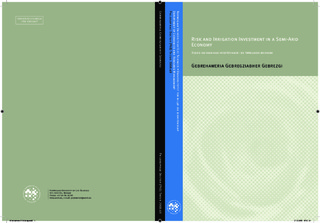| dc.contributor.advisor | Holden, Stein | |
| dc.contributor.author | Gebrezgi, Gebrehaweria Gebregziabher | |
| dc.date.accessioned | 2017-02-16T16:31:57Z | |
| dc.date.available | 2017-02-16T16:31:57Z | |
| dc.date.issued | 2008 | |
| dc.identifier.isbn | 978-82-575-0852-4 | |
| dc.identifier.issn | 1503-1667 | |
| dc.identifier.uri | http://hdl.handle.net/11250/2431142 | |
| dc.description.abstract | The thesis consists of an introduction and four independent papers. It investigates the role of production risk and irrigation investment on farm households’ production decisions, efficiency, and income. Paper I analyses whether land rental contract choice depends on poverty, capital constraints, production risk and random shocks. It shows that poor households experiencing random shocks are more likely to choose fixed rent contracts as a distress response to shocks implying that fixed rent contracts may be used to meet immediate needs. It also revealed that fixed rent contracts are preferred when production risk is low (such as in irrigated land), while sharecropping is more likely when production risk is high. Paper II examines how production risk, access to irrigation, and food deficits affect households’ fertilizer adoption. A positive and significant synergy exists between irrigation and fertilizer use, while a negative relationship exists between risk and fertilizer adoption. A higher probability of households being food self sufficient was negatively associated with the probability of fertilizer use. Similarly, food deficit households predicted to be so were less likely to use fertilizer. However, the food deficit households who decided to use fertilizer, used significantly higher amount of fertilizer than households that did not face food deficit. Paper III assesses the technical efficiency of farmers on irrigated and rain-fed land. It also assesses whether irrigation expands the smallholders’ production frontier, and whether there is a room to increase agricultural production given the current input use and technology. Results indicate that irrigation has expanded the production frontier, but farmers are more efficient on their rain-fed plots than irrigated plots suggesting that that there is huge untapped potential in irrigated agriculture. Paper IV assesses the income effects of irrigation investments and finds that irrigation investment has significantly improved household income and reduced poverty. Groundwater-based irrigation projects have higher income effect than micro-dam and river diversion suggesting that the use of water-saving technologies (such as pressurized tube irrigation and manually operated shallow-well) may reduce water losses due to run-off and excess percolation. | nb_NO |
| dc.language.iso | eng | nb_NO |
| dc.publisher | Norwegian University of Life Sciences, Ås | nb_NO |
| dc.relation.ispartofseries | PhD Thesis;2008:49 | |
| dc.rights | Attribution-NonCommercial-NoDerivatives 4.0 Internasjonal | * |
| dc.rights.uri | http://creativecommons.org/licenses/by-nc-nd/4.0/deed.no | * |
| dc.title | Risk and irrigation investment in a semi-arid economy | nb_NO |
| dc.title.alternative | Risiko og vanningsinvesteringer i en tørrlands økonomi | nb_NO |
| dc.type | Doctoral thesis | nb_NO |
| dc.subject.nsi | VDP::Social science: 200::Economics: 210::Economics: 212 | nb_NO |
| dc.source.pagenumber | 184 | nb_NO |

